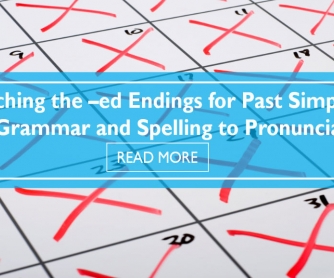There are so many layers to teaching English that it can be overwhelming for both the student and the teacher. English has many “if this, then that” rules and so many special circumstances that it can be hard to keep it all straight! It's true, English is a crazy language! Here’s everything you need to know plus some useful resources on how to teach -ed endings in American English.
When to Use -ed Endings (Past Tense):
I’m sure you already know this one, but let’s go over it for the sake of being thorough. We end verbs with -ed when we want to signify that something has already happened, it’s in the past. Many verbs follow this rule, but of course there are some “if this, then that” rules that we need to follow for spelling, which we will discuss in the next section. There are also irregular verbs that just want to do their own thing. These are probably some of the toughest to teach, but they’re really important! Here is an awesome resource that goes over irregular verbs, examples, and definitions.
The Spelling of -ed Endings:
As I mentioned above, there are some “if this, then that” rules that need to be followed with writing in past tense. For these rules, I will use C for consonant and V for vowel.
1. If the verb ends in e then simple add -d to the end (not -ed).
like > liked
move > moved
2. If the verb ends in C+y then change the y to i and add -ed.
study > studied
hurry > hurried
3. If the verb is one syllable and ends in a combination of CVC then double the last C and add -ed.
plan > planned
stop > stopped
4. If the verb is more than one syllable and the last syllable is stressed then double the last C and add -ed.
regret > regretted
commit > committed
Pronouncing the -ed Verb Endings:
Since you’re working on -ed endings, it’s imperative to get some speaking practice in your lesson! English students tend to pronounce -ed endings inaccurately a lot, so this is important. Here are some guidelines to help with your lesson.
1. If a verb ends in the sounds /b/, /g/, /ð/, /v/, /z/, /dʒ/, /m/, /n/, /ŋ/, /r/, /l/ then -ed sounds like /d/.
- 2. If a verb ends in the sounds /p/, /k/, /θ/, /f/, /s/, /⟆/, /t⟆/ then -ed sounds like /t/.
- 3. If a verb ends in the sounds /t/ or /d/ then -ed sounds like /id/.
Here are some great resources from BusyTeacher.org to help you with teaching this:
Past Simple BINGO - Irregular Verbs
Speaking with Past Simple Regular Verbs
Present Simple vs. Past Simple Question Practice (Speaking)
Where Did He Go? How to Teach Question-Making in Past Tense
Snakes and Ladders Past Simple
6 Super ESL Games for Grammar Review
P.S. If you enjoyed this article, please help spread it by clicking one of those sharing buttons below. And if you are interested in more, you should follow our Facebook page where we share more about creative, non-boring ways to teach English.








